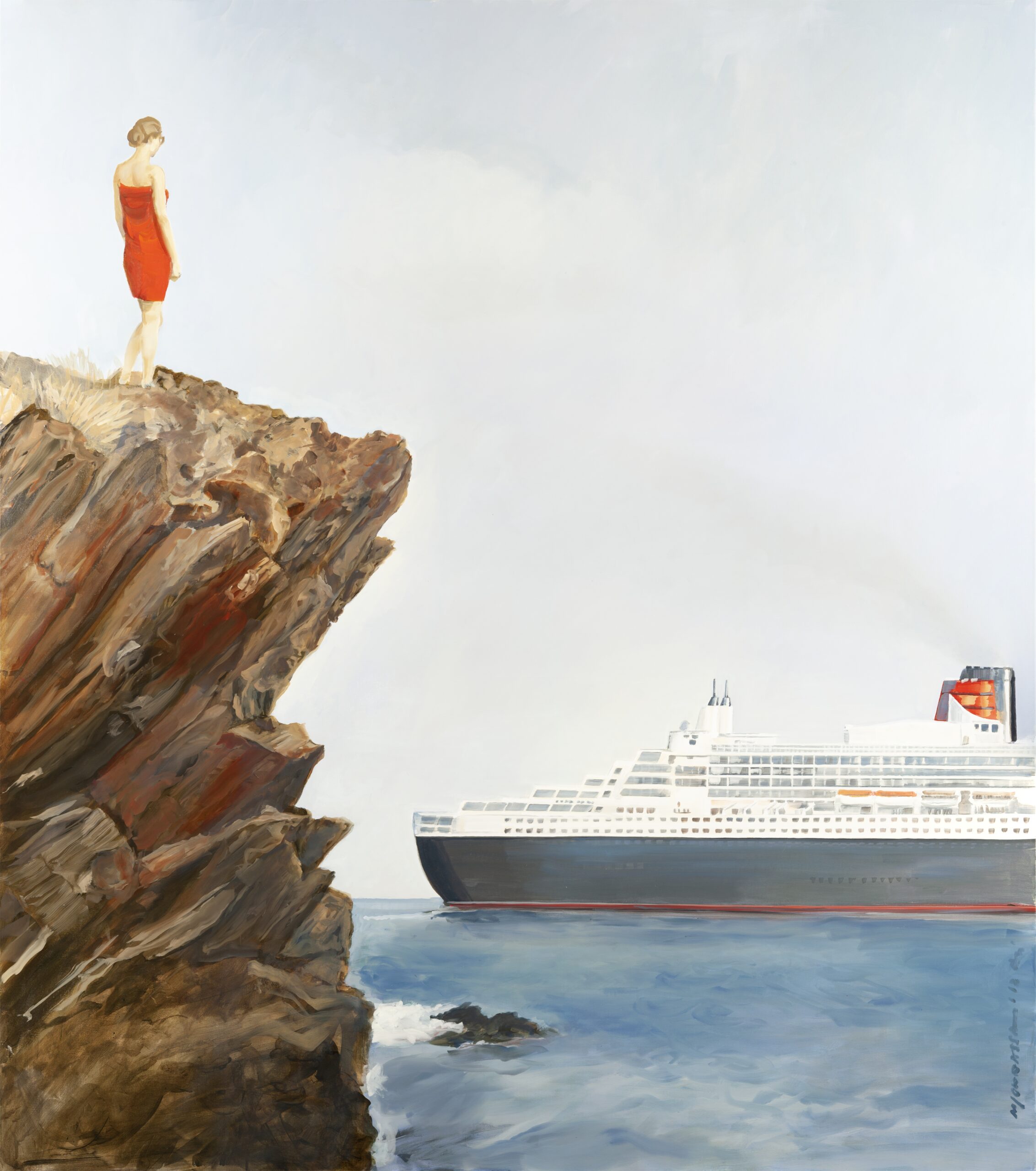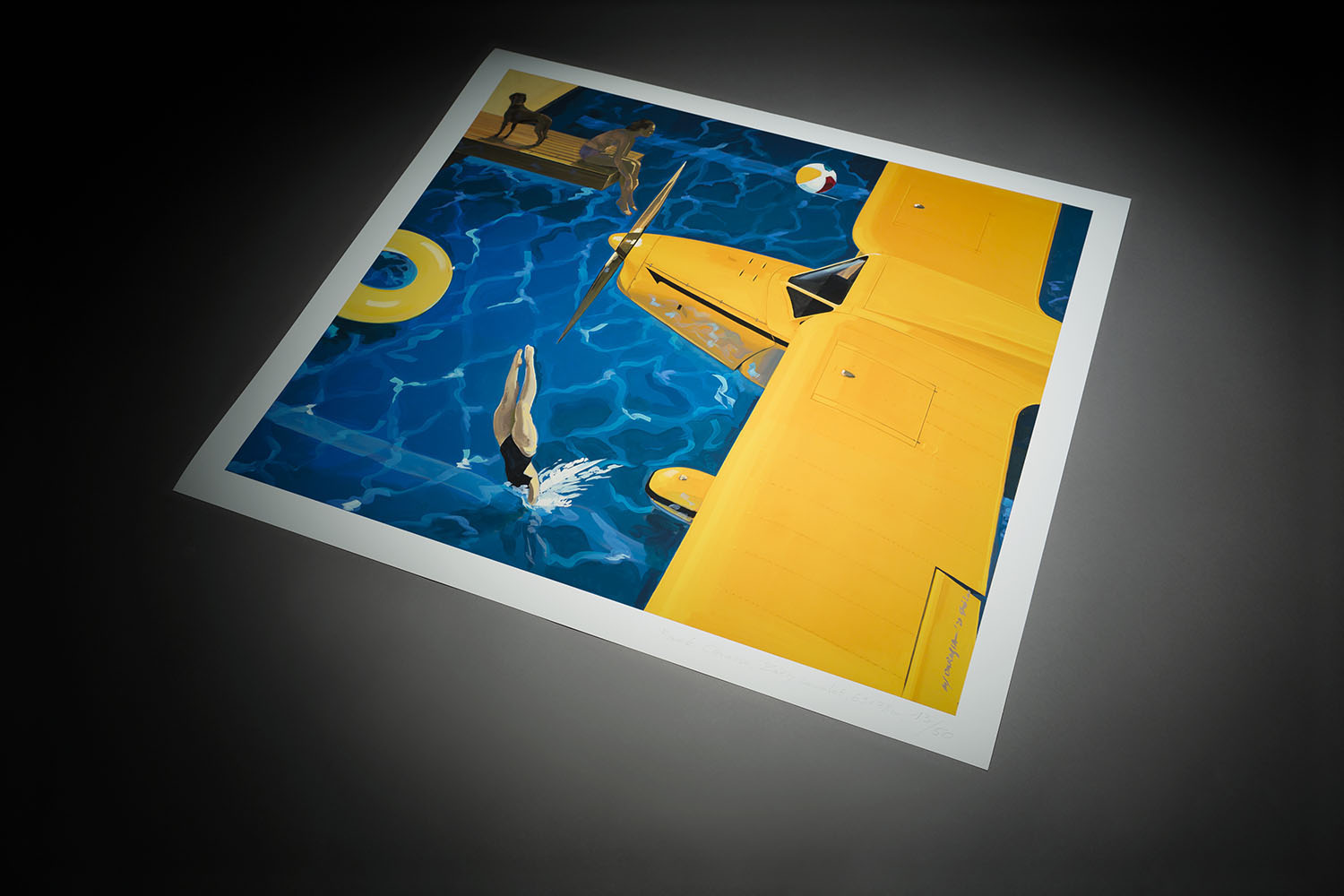
With these paintings one would even like to exclaim: there goes youth!!! Full of vigor, conquering, delighted with herself, perhaps even a little unceremonious… Ba, she’s not even walking, she’s dancing, moving in some kind of thrilling, modernist parade; at times rushing like mad; chasing down a multi-lane highway, only to observe the world from the height of a transcontinental plane soaring over the city.
In this world there is no center, no periphery, axiological distinctions are blurred: good and bad, noble and trivial, familiar and exotic; even between ugliness and beauty it is difficult to see clear boundaries: what is far – here becomes close, close – far; contradictions seem to be adjacent to each other on the increasingly flat liquid crystal screen of human consciousness. This is how modern Bacchanalia happens, in terms of its nature and cultural significance – if the matter is well studied – not so different from those lived by man of the ancient Greek and Roman agons, when Dionysian use and affluence fought a fierce battle with the Apollonian principle of moderation and harmony – a battle to the point of mutual exhaustion, to mutual death.
This is also how I recognize the world depicted in these canvases: a super-modern Dionysian procession, an ecstatic dance (a frequent motif in Mark Okrassa’s canvases, by the way) of people, gods and things, a permanent celebration of the abundance of light, shapes and colors emerging from it. It (the light) seems to be in this painting the most important disposer of aesthetic (and not only!) energies of each painting; it flows from everywhere (not even modeling its depth and most often leaving no shadow), seizes almost every corner of the canvas, sometimes even seems to pour out of its frames. Together with the viewer, it wants to celebrate its omnipresence, generosity, barely restrained unbridledness and vitalistic excess. The light here is strong, juicy, gushing with intense colors; I would say: even expansive, possessive, as it tears color away from its local assignments, and with color – things and their associated events, to… carry them into some half-real, half-imaginary spaces.
For this reason, in Okrassa’s paintings there are no clear divisions between the various sequences of events, indeed, there are no clear demarcations between the individual works: one seems – sometimes perversely, sometimes seriously – to refer to the other; one remains in some kind of passionate dialogue with the other, one calls the other into existence; one plays with the relations established between them, teases, plays games. Nothing here is once and for all finished, everything in constant motion, dynamic, constantly open to the next and the next adventure. Despite the rather clear attention to the painterly sovereignty of each work, there are in fact quite a few provocative incompletions here; the framing – in some aspects extremely careful – often covers only a part of things, or more broadly of reality, e.g. a fragment of the gangway at a luxury cruise ship, the front part of the hood of the latest model of Mercedes, the exquisite red slipper of a lady getting out of a silver car – all as if it were some extract from a fast-paced cinematic narrative… Reality is sometimes caught here in an instant, with a sudden gesture, captured in a rapidly realized shortcut (because there is no time, because… “such is our time”), perceived: from above, from the side, from below, from a frog’s perspective, seen and processed from different angles, situated on various spatial and temporal planes, often as surprisingly as it happens on a TV video clip or on an advertising pole, where a flashy circus announcement coexists with an advertisement for the latest washing powder and a photocopied picture of a dog (“I’ll give it away to good hands”).
In the work of the Sopot artist, various painting conventions, styles and manners are adjacent, sometimes supporting each other, sometimes falling into an interesting dispute. This painting wholeheartedly praises the free market of stylistic, thematic or ideological offerings. Okrassa is often baroque and classical, modern and findesiecl, uses sublime means, tried and tested by tradition, and without hesitation reaches for the tools most contemporary to him: he uses the camera, the computer, the aesthetics of the poster, the poetics of sharp cuts and juxtapositions of avant-garde cinema; in a word – he is not afraid of experimentation. I would even say that he is youthfully greedy for them: constantly in the heat of creative exploration, constantly on the road, on the fast highway of modernity.
Even nature participates with him in this accelerated course of civilizational transformations; it is constantly being subjected to the pressure of cultural conventions, turned into a commercial offer, transformed into a commercial logo, into an advertising sign: after all, if a beach – it is one with deck chairs, with a table on which champagne and chilled melons, nay, for the “forsy” there can also be a couch on display, for bored gentlemen – a nude girl for company on it… Everything here can be staged, turned into a cultural dummy, into a product for easy consumption, wrapped in multicolored paper. Okrassa depicts this world in sharp colors and expressive shapes, built up with strong brushstrokes, she often surrounds them with a thick line, but does not pin down ambiguous terms, avoids intrusive commentary. He seems to say: let this civilization of mine roll on, since it seems so content with itself, since it wants to suffice itself. To him, a grotesque abbreviation, a touch of irony, the serious transformed into a joke, into a pretense, into a carnivalesque spectacle of masks, suffices for all commentary. (Although – it happens – I also come to such a reflection, is it sometimes not a ball on the Titanic, when the audience gathered in the salons still does not realize the horror of its own position? Of what is about to come?). A little, or maybe even a lot of postmodern decadence here (but in what a youthful way!), sometimes – a touch of melancholy. In any case, mostly: high-life, VIPs, cover ladies – beneficiaries of civilization’s affluence, demanding ever stronger excitement for their blasé minds.
I must admit that I’m a little envious of Marek Okrassa’s passionate embrace of modernity; maybe not necessarily of the world just mentioned (which I know more from browsing through “Twój Styl”, “Tina” or “Naj” magazines at the neighborhood hairdresser’s, rather than from my own experience), but precisely: this youthful curiosity about everything that is new; this dynamic of engagement with novelty. I hope it’s such a positive, creative envy… I’ll also say at the end that the view from the window of my room is a little different than in his paintings: a ten-story block of flats on the right, garages on the left, between them on crooked concrete slabs cars of various makes (I can no longer keep up with identifying which ones are called), on a patch of asphalt kids playing, further on – garbage containers, near them neighborhood drunks “downing” another beer today; I can also see my neighbor Mr. Zygmunt – a pensioner with difficulty carrying a shopping net: bread, potatoes, milk, “Nasz Dziennik”…
Sometimes, I admit, I feel a little sad that Mr. Zygmunt will no longer make it to the great modern art.
Header illustration: Marek Okrassa The Rock, 2012, oil on canvas 180×160 cm (Translated with DeepL.com).


